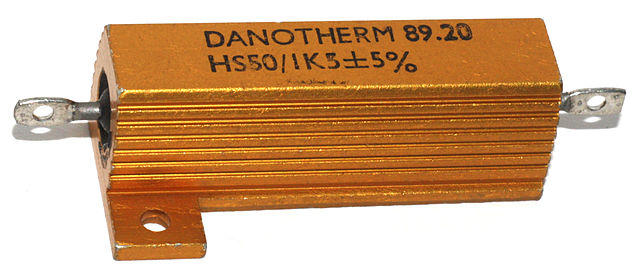An electronic color code or electronic colour code is used to indicate the values or ratings of electronic components, usually for resistors, but also for capacitors, inductors, diodes and others. A separate code, the 25-pair color code, is used to identify wires in some telecommunications cables. Different codes are used for wire leads on devices such as transformers or in building wiring.
A 2.26 kΩ, 1%-precision resistor with 5 color bands (E96 series), from top, 2-2-6-1-1; the last two brown bands indicate the multiplier (×10) and the tolerance (1%).
RMA resistor color code guide, ca. 1945–1950
Example color-coded resistors
Postage-stamp mica capacitors marked with the EIA 3-dot and 6-dot color codes, giving capacitance value, tolerance, working voltage, and temperature characteristic. This style of capacitor was used in vacuum-tube equipment.
A resistor is a passive two-terminal electrical component that implements electrical resistance as a circuit element. In electronic circuits, resistors are used to reduce current flow, adjust signal levels, to divide voltages, bias active elements, and terminate transmission lines, among other uses. High-power resistors that can dissipate many watts of electrical power as heat may be used as part of motor controls, in power distribution systems, or as test loads for generators.
Fixed resistors have resistances that only change slightly with temperature, time or operating voltage. Variable resistors can be used to adjust circuit elements, or as sensing devices for heat, light, humidity, force, or chemical activity.
Various resistor types of different shapes and sizes
An aluminium-encased power resistor rated for dissipation of 50 W when mounted on a heat-sink
VZR power resistor 1.5 kΩ 12 W, manufactured in 1963 in the Soviet Union
Axial resistors with wire leads for through-hole mounting








